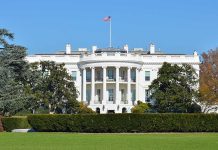
Two masked figures flee Harvard Medical School in the dead of night, leaving behind an intentional explosion—and a trail of questions more explosive than the event itself.
Story Snapshot
- Authorities confirm the explosion at Harvard Medical School was a deliberate act, sparking an FBI-led manhunt for two unidentified suspects.
- No injuries or major damage, but the incident exposes vulnerabilities at one of the world’s most prestigious research institutions.
- Surveillance images released; investigation ongoing, with campus safety protocols under intense review.
- The motives remain elusive, amplifying tension and speculation throughout the academic and law enforcement communities.
Explosion at the Heart of Harvard’s Research Empire
At 2:45 a.m. on a quiet Saturday, the fire alarm pierced the silence inside the Goldenson Building, deep within Harvard Medical School’s sprawling Longwood Medical Area. Responding officers caught sight of two masked figures fleeing the fourth floor, just moments before discovering the remnants of an explosion. The Boston Fire Department’s Arson Unit and the FBI swiftly joined the investigation, recognizing the act was no accident but a calculated breach of security at one of America’s scientific crown jewels.
The Goldenson Building, home to cutting-edge neurobiology labs, stands as a symbol of biomedical innovation. The deliberate explosion sent shockwaves not just through Harvard’s corridors, but across the entire sector—reminding everyone that even elite institutions remain vulnerable to disruption. Campus officials, law enforcement, and federal agents moved quickly. The building was swept for additional devices, and, by morning, Harvard Medical School administration assured the community: no injuries, no structural damage, and full operational status. But the sense of invulnerability had already been shattered.
Investigation Unfolds Under the Public Eye
Within hours, surveillance images of the fleeing suspects were released, turning the investigation into a citywide search and a national headline. The FBI’s involvement highlighted the seriousness of the incident and signaled that the authorities were considering all possible motives, from personal grievance to ideological protest. The investigation remains active, with law enforcement urging public assistance to identify the perpetrators. The lack of immediate leads has fueled speculation, yet official sources refrain from conjecture, emphasizing that facts—not theories—will drive the inquiry forward.
Harvard’s administration worked in tandem with campus police and federal agents, balancing transparency with caution. Communications to faculty, students, and staff focused on reassurance: increased security, ongoing investigation, and a commitment to community safety. The decision to reopen the Goldenson Building within days signaled resilience, but also the necessity of returning to the business of research—a business that now faces new questions about preparedness and risk.
Ripple Effects on Campus Security and Reputation
Short-term fallout included heightened anxiety among Harvard’s students, faculty, and staff, and a visible surge in law enforcement presence. The disruption to research was brief, but the psychological impact will likely linger. The incident has triggered a review—and probable tightening—of campus security protocols, not just at Harvard but across comparable institutions.
Long-term consequences remain uncertain, hinging in part on the eventual revelation of motive and identity. If the perpetrators turn out to be ideologically motivated or linked to broader debates about higher education, the reputational stakes could escalate. For now, the event stands as a stark reminder that even the most renowned campuses must contend with threats that defy prediction and simple explanation. Security experts caution that rare but calculated attacks on research facilities can have outsized effects, shaping public perception and institutional policy for years to come.
Expert Perspectives and the Search for Meaning
Industry analysts, security experts, and academic leaders agree: swift communication and transparent investigation are critical in maintaining trust during crises. The Harvard Medical School explosion, while causing no physical harm, has exposed both the strengths and limitations of campus safety infrastructure. The debate now centers on how institutions balance openness and accessibility with the imperative to protect people and research from intentional disruption.
Official statements from Harvard, the Boston Fire Department, and the FBI have been measured and consistent, leaving little room for wild speculation. Yet, as long as the suspects remain at large and their motives unknown, the community’s curiosity—and anxiety—will keep the story alive. For America’s leading research universities, the lesson is clear: vigilance and preparedness must evolve faster than the threats themselves. The Harvard Medical School explosion may prove to be a turning point in how elite institutions approach security in an increasingly unpredictable world.
Sources:
Harvard Medical School official update










